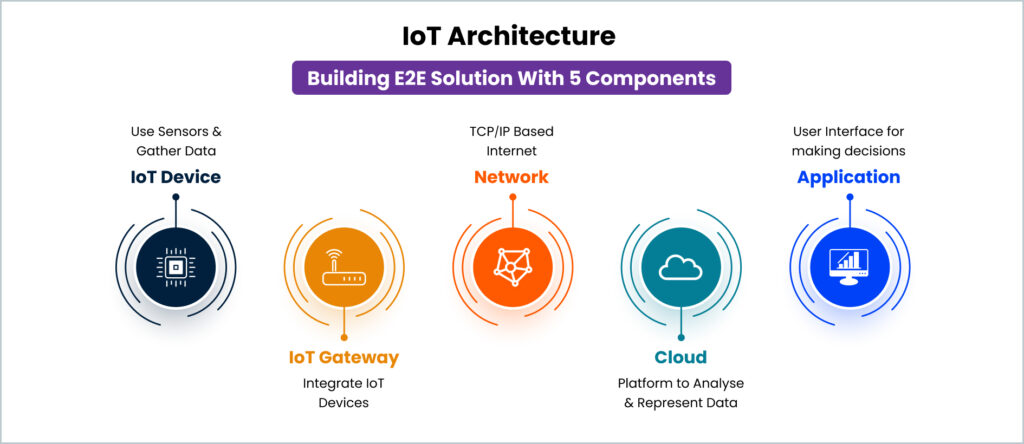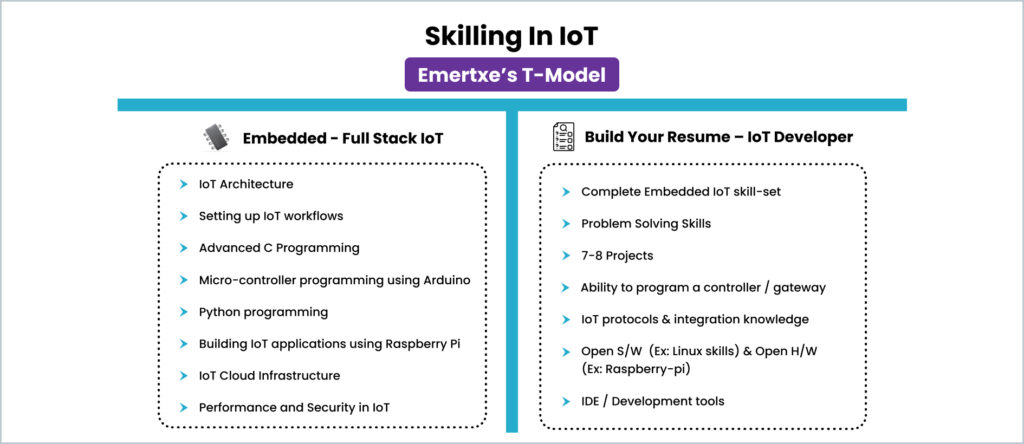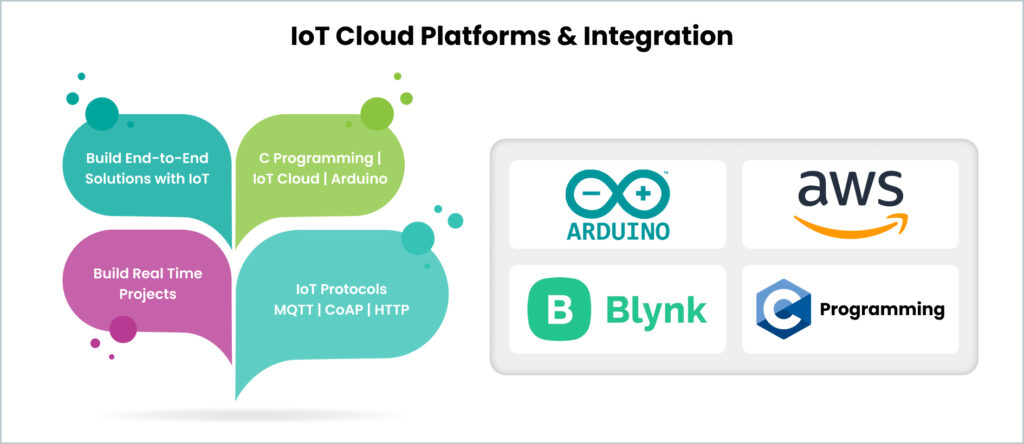Introduction
The Internet of Things (IoT) is revolutionizing how we interact with technology, enabling smarter, more connected devices across various industries. From smart homes and wearables to industrial automation and smart cities, IoT applications are everywhere. To thrive in this dynamic field, engineers need a robust understanding of IoT technologies and skills.
Enrolling in an IoT certification course, such as those offered by Emertxe in Bangalore, can equip you with the necessary expertise to excel in this transformative domain. Let’s explore the top skills you will learn in an IoT certification course in detail.
A Brief about IoT
Before diving into specific skills, it’s essential to grasp the foundational aspects of IoT and certification courses. An IoT certification course typically begins with an introduction to IoT, covering its history, evolution, and future trends.
You’ll learn about the key components of IoT systems, including IoT devices, gateways, cloud platforms, and applications. Understanding these basics is crucial for building more advanced IoT solutions.
As IoT solutions scale, serving millions of users, security and scalability come into picture. As an entry-level engineer who is willing to start a career in IoT, you need to have these aspects in mind during the design and implementation phase. Now let us take a look into how Emertxe’s IoT course takes a systematic journey of skill building.

IoT Certification Course by Emertxe
Emetxe’s IoT certification course is designed to provide a comprehensive education in the various skills needed to develop and manage IoT solutions. Here are the core skills you can expect to gain:
1. Programming Skills - C & Python
C Programming:
C programming is fundamental for developing software that runs on IoT devices, particularly Embedded Systems. In an IoT certification course, you will delve into:
Basic to Advanced C Programming Concepts: You’ll start with the basics of C programming, including syntax, data types, and control structures. As you progress, you’ll explore more complex topics such as pointers, memory management, and data structures.
Memory Management: Understanding how to efficiently manage memory is crucial in embedded systems, where resources are limited. You’ll learn about dynamic memory allocation, de allocation, and memory optimization techniques.
File Handling and Modular Programming: You’ll gain skills in handling files and creating modular code, which is essential for building scalable and maintainable software.
Example: Developing firmware for an IoT sensor node or device that collects environmental data and communicates with a IoT gateway for further analysis.
Python Programming:
Python is widely used in IoT applications due to its simplicity, readability, and vast ecosystem of libraries. The Python programming module will cover:
Python Syntax and Basic Programming Constructs: You’ll learn the fundamentals of Python programming, including syntax, data types, and control flow statements.
Object-Oriented Programming (OOP) with Python: OOP is a programming paradigm that helps in structuring software in a way that is easy to manage and extend. You’ll learn how to create and use classes and objects, inheritance, polymorphism, and encapsulation in Python.
Data Handling and Manipulation with Python Libraries: You’ll explore Python libraries such as Pandas and NumPy for data manipulation and analysis, which are critical for processing IoT data.
Example: Writing a Python script to process and visualize data from IoT devices or building a fundamental multi-tasking application that enables it.
2. Microcontroller / IoT Device Programming Skills - Node MCU
Microcontrollers are the heart of IoT devices, enabling them to sense and control the physical world. In our IoT certification course, you will learn the following skills:
Microcontroller Architecture and Interfacing: You’ll gain a deep understanding of Microcontroller architecture, including how to interface with various sensors and actuators.
Programming Microcontrollers Using the Arduino IDE: The Arduino platform is a popular choice for IoT projects due to its ease of use and extensive community support. You’ll learn to program Microcontrollers using the Arduino Integrated Development Environment (IDE).
Working with GPIOs, Timers, and Communication Protocols: You’ll explore how to use General Purpose Input/Output (GPIO) pins, timers, and communication protocols such as I2C, SPI, and UART to interact with other devices.
Example: Programming a NodeMCU to control home automation systems, such as lights and appliances, remotely via a smartphone app.

3. IoT Gateway Programming
IoT gateways play a crucial role in connecting IoT devices to the cloud, enabling data aggregation, processing, and transmission. In our IoT certification course, you’ll learn to:
Set Up and Configure IoT Gateways Using Raspberry Pi: Raspberry Pi is a versatile and cost-effective platform for building IoT gateways. You’ll learn how to set up and configure a Raspberry Pi as an IoT gateway.
Develop Applications on Raspberry Pi with Python: You’ll develop Python applications that run on Raspberry Pi, enabling it to collect data from IoT devices and send it to the cloud.
Implement IoT Protocols Like MQTT and HTTP: You’ll explore IoT communication protocols such as MQTT (Message Queuing Telemetry Transport) and HTTP (Hypertext Transfer Protocol), which are essential for transmitting data between devices and the cloud.
Example: Configuring a Raspberry Pi to collect data from multiple IoT devices and send it to a cloud server for real-time analysis and visualization using MQTT or HTTP protocols.
4. IoT Cloud
Cloud platforms are integral to managing, storing, and analyzing IoT data. This module covers:
Configuring IoT Cloud Platforms: You’ll learn to set up and configure any one or many of the IoT cloud platforms such as AWS IoT, Azure IoT, or Google Cloud IoT. You will also explore OpenSource IoT cloud platforms as well.
Data Monitoring and Analytics: You’ll explore tools and techniques for monitoring IoT data in real-time and performing analytics to derive meaningful insights.
Device Configuration and Management Using REST APIs: You’ll learn to use REST APIs to manage and configure IoT devices remotely, enabling seamless integration between the cloud and IoT devices.
Example: Setting up an AWS IoT instance to monitor real-time data from smart home devices, create dashboards for data visualization, and trigger alerts based on predefined conditions.

5. Security and Performance in IoT
As mentioned above, security is a critical aspect of IoT due to the potential risks and vulnerabilities associated with connected devices. The same thing applies to performance where the IoT should be able to meet certain throughput criteria as expected by customers. Both security and performance are subjects of its own, however its important to have them into consideration when you will go about building a real-time IoT solution.
In Emertxe’s IoT certification course, you will learn:
Identifying and Mitigating Security Risks in IoT Systems: You’ll explore common security threats and vulnerabilities in IoT systems and learn strategies to mitigate these risks.
Implementing Cryptography and Secure Communication Protocols: You’ll gain an understanding of cryptographic techniques and secure communication protocols, such as SSL/TLS, to protect data integrity and confidentiality.
Performance Tuning and Bench-marking IoT Applications: You’ll learn techniques for optimizing the performance of IoT applications, including resource management, latency reduction, and scalability.
Example: Securing an IoT network with encryption and secure authentication mechanisms to protect sensitive data from unauthorized access and cyber-attacks.
Conclusion
An IoT certification course offers a comprehensive skill set that prepares you for a thriving career in the IoT industry. By covering essential topics such as programming, device and gateway configuration, cloud integration, and security, these courses ensure that you are well-equipped to tackle the challenges of IoT development. Institutions like Emertxe in Bangalore provide extensive training and placement support, making them an excellent choice for aspiring IoT professionals.
| Serial No. | Related Blogs | Links |
|---|---|---|
| 1. | Future Trends in IoT: Insights from Bangalore’s Tech Experts | Click Here |
| 2. | How to Build Internet of Things (IoT) Projects for Freshers | Click Here |
| 3. | Introduction to IoT for Beginners : Kickstart your career growth | Click Here |
People Also Ask (PAA)
IoT certification courses teach essential skills such as programming (C and Python), microcontroller interfacing, IoT gateway setup, cloud platform configuration, and security measures.
IoT certification courses provide expertise in cutting-edge IoT technologies, enhancing career opportunities in industries like smart homes, industrial automation, and smart cities.
Essential programming languages for IoT development include C and Python. C is fundamental for embedded systems, while Python is versatile for data handling and application development.
Emertxe’s IoT course is recommended for its comprehensive curriculum, hands-on projects, and placement support, preparing students for successful careers in the IoT industry.
